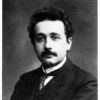-
Posts
4 -
Joined
-
Last visited
Content Type
Profiles
Forums
Events
Posts posted by Rahul08
-
-
Oh yes, Thank you for correcting me. I forgot for a moment tht velocity is a vector quantity.

Thanks xyzt.
 0
0 -
The satellite actually move in horizontal direction.But according to general relativity, the gravity of the earth just curves the space time fabric. the satellite then falls ito this circular curve and revolves around the earth.
To understand this, we can use an example:
Hold a rubber sheet. Place a ball on the cetre of the sheet. Now the ball curves the sheet around it. If we let another small ball in any direction, the ball will automatically revolve around the earlier ball.
This path is called its orbit.
To my knowledge, Acceleration is change in velocity with time, but not change in direction.
I think this image will give you a better idea.

Please correct me if i am wrong.
0 -
1. Heat. Higher temperatures make all other forms of matter speed up, I don't see why light would be an exception. I'm not sure whether this has been tested, but logically there should be some kind of difference in speed between the light being released from an immensely hot light source (let's say a star) and the light lost out in freezing space. Furthermore, what state of matter is light exactly? Plasma?I agree with you that high temperatures can increase the kinetic energy of a matter. But one should not forget the basic fact that light is not a matter, but its just a form of energy. So it can only be converted into one form to another, such as heat.
According to laws of physics, Speed of light remains constant irrespective of the speed of source. One would observe the speed of light to be the same at all state (motion or rest). The speed of light only changes when it enters from one medium to another of different optical densities, a phenomenon called as refraction.
2. Distance. I know this is wrong, but I don't understand how waves (or wave-like particles) maintain 100% of their energy when crossing the absolute emptiness of space. Movement is energy, including wave-like movement, and therefore some of that energy should be expended. Especially in the case of mass, when it is solid, physical matter that must move back and forth. There is something going on here that I am not aware of, I'm sure. But I felt like I should mention it.
Now, this question can be answered from one of the points from above. As I have said, light consists of energy. I agree with you that some of energy is required to move a mass object. But, light particles, called as photons are massless (m=0). Then how would you expect to expend its own energy for movement.
3. Force. As with any object, when light hits something, some of its energy should be transferred into the other object. According to this, light should slow down a bit each time it hits something, for instance an atmospheric molecule.Again, you are right. Yes, it is true that when light hits an object it transfers some of its energy to the sub-atomic particles present in the object. We can take example of the compton scattering effect. After hitting a charged particle, say electron, the energy of photon decreases and its wavelength increases ( such as those of gamma rays and x rays). I am not sure, but i think these again recombine with an other beam of light in appropriate proportion. In this way, energy will be conserved and would not contradic the law of conservation of energy.
I would prefer any expert in this forum to explain this thing more correctly.
And I'll answer your last questions soon, as its my time to lunch. So I am posting these all now
0



The acceleration due to gravity should be less or the same on the equator than on the poles?
in Homework Help
Posted
Earth, being a sphere, is bulged out at the equator.So the distance between the centre of mass and the surface of earth is higher at the equator than at the pole. We know,according to newton's law of gravity, that the gravitational force is inversely proportional to the square of distances between two bodies. So, the gravitational force on the surface of earth at the equator becomes less and hence the acceleration becomes less.
To say accurately, The gravity at the equator becomes 0.53% less than that at the poles and hence, the acceleration becomes 0.18% less,that is, 9.78 m/s^2.
Conclusion: Gravity is stronger at the poles than at the equator.
Hope this helps You.
Please correct me if i am wrong.